Famous Photographers - Ansel Adams

Ansel Adams: Classic Images |
Famous Photographers >> Ansel Adams
Ansel Easton Adams (1902-1984) was born in San Francisco.
His Aunt Mary gave him a copy of "In the Heart of the Sierras" when he was sick as a child. The photographs in the book by George Fiske piqued his interest enough to persuade his parents to vacation in Yosemite National Park in 1916, where he was given a camera as a gift.
Adams disliked the uniformity of the education system and left school in 1915 to educate himself. He originally trained himself as a pianist, but Yosemite and the camera diverted his interest toward photography. He later met his future wife, Virginia Best, in Yosemite. Adams long alternated between a career as a concert pianist and one as a photographer.

Half Dome, Merced River, Winter 
Nevada Fall, Rainbow, Yosemite National Park, 1946 |
At age 17 Adams joined the Sierra Club, a group dedicated to preserving the natural world's wonders and resources. He remained a member thorughout his lifetime and served as a director, as did his wife, Virginia. Adams was an avid mountaineer in his youth and participated in the club's annual "high trips", and was later responsible for several first ascents in the Sierra Nevada. It was at Half Dome in 1927 that he first found that he could make photographs that were, in his own words, "...an austere and blazing poetry of the real". Adams became an environmentalist, and his photographs are a record of what many of these national parks were like before human intervention and travel. His work has promoted many of the goals of the Sierra Club and brought environmental issues to light.
Adams is famous for his black & white landscape photographs of the national parks (Yosemite National Park among others), and as an author of numerous books about photography, including his trilogy of technical instruction manuals (The Camera, The Negative and The Print). He co-founded the photographic association Group f/64 along with other masters like Edward Weston, Willard Van Dyke, Imogen Cunningham and others.
Adams invented the zone system, a technique which allows photographers to translate the light they see into specific densities on negatives and paper, thus giving them better control over finished photographs. Adams also pioneered the idea of visualization (which he often called 'previsualization', though he later acknowledged that term to be a redundancy) of the finished print based upon the measured light values in the scene being photographed.
Photographs in Adams' limited edition book, Sierra Nevada: The John Muir Trail, along with his testimony, are credited with helping secure the designation of Sequoia and Kings Canyon as national parks in 1940.
During World War Two Adams worked on creating epic photographic murals for the Department of the Interior. Adams was distressed by the Japanese American Internment that occurred after the Pearl Harbor attack. He was given permission to visit the Manzanar War Relocation Center in the Owens Valley, at the foot of Mount Williamson. The resulting photo-essay first appeared in a Museum of Modern Art exhibit, and later was published as Born Free and Equal: Photographs of the loyal Japanese-Americans at Manzanar Relocation Center, Inyo County, California.
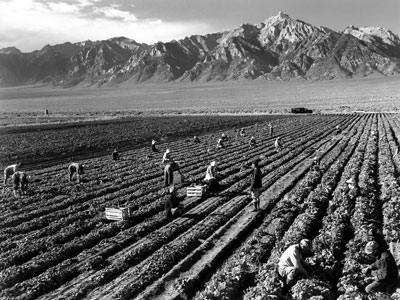
Farm workers at Manzanar War Relocation Center with Mt. Williamson in the background.
Adams was the recipient of three Guggenheim fellowships during his career. He was elected in 1966 a Fellow of the American Academy of Arts and Sciences. In 1980 Jimmy Carter awarded him the Presidential Medal of Freedom, the nation's highest civilian honor.
The Minarets Wilderness in the Inyo National Forest was renamed the Ansel Adams Wilderness in 1984 in his honor. Mount Ansel Adams, a 11,760' peak in the Sierra Nevada, was named for him in 1985.
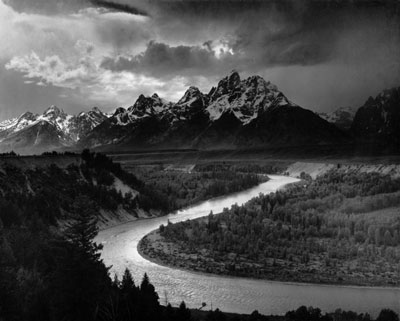
The Tetons - Snake River (1942)
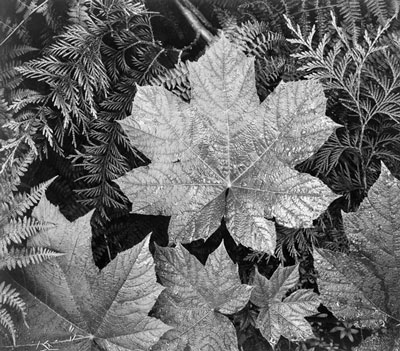
Close-up of leaves in Glacier National Park (1942)
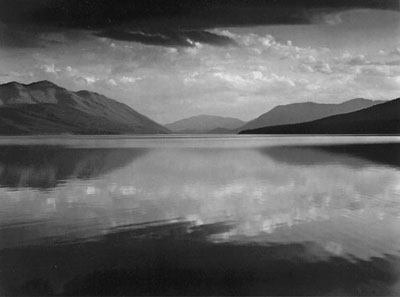
Evening, McDonald Lake, Glacier National Park (1942)
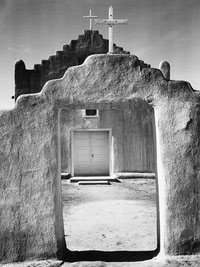
Adams Church, Taos, Pueblo (1942)
Further Information
Recommended Reading
On the Web
Ansel Adams at 100 from the San Francisco Museum of Modern Art. Focusing on seven key works, this interactive multimedia program provides insights into the history and world of ideas behind Adams' photography.
This article is licensed under the GNU
Free Documentation License. It uses material from the Wikipedia article
"Ansel
Adams ". The images by Ansel Adams used in this article, retrieved
from Wikipedia, are in the
public domain because they contain material that originally came from
the United States Government.





